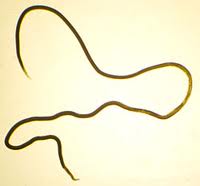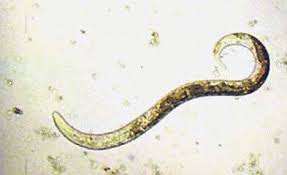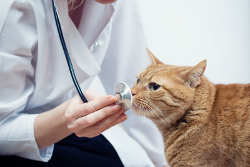There are many different forms of parasites that can infect a cat in various ways. Most of them share similar traits, behaviors and life cycles. Lung worms, however, are unique because this particular parasite will die on its own, even if left untreated.
This is also a parasite that can only be contracted through ingestion. Unfortunately, there are several ways your cat can inadvertently ingest the worm. Even if your cat does contract lung worms, the infection can be easily treated once it’s correctly diagnosed. It’s important to note that lung worms are more commonly found in younger cats and cats that are outdoors often.
What Are Lung Worms?
 Lungworms are parasites that will infect a cat’s lungs and reside there. For cats, specifically, there are two common types of lung worms they are affected by:
Lungworms are parasites that will infect a cat’s lungs and reside there. For cats, specifically, there are two common types of lung worms they are affected by:
- Aelurostrongylus abstrusus
- Capillaria aerophila
These parasites are very different from other, more common parasites. Unlike the majority of parasites that will keep on feeding until they are dealt with, these parasites will actually die with time. However, that does not mean that they can just be ignored. If left untreated, there can be serious permanent damage in the form of scar tissue throughout your cat’s lungs.
These parasites can do a lot of damage in a very short amount of time and can severely harm your cat’s lungs. This can include, and is not limited to infections and even pneumonia which can also lead to death. The resulting coughing can also become permanent if left untreated.
What Causes Lung Worms?
 Lung worms can be ingested a number of different ways from drinking contaminated water, to consuming an intermediate host such as:
Lung worms can be ingested a number of different ways from drinking contaminated water, to consuming an intermediate host such as:
- Small birds
- Snails
- Slugs
- Various insects
The intermediate host may also have asexual larval if it was able to grow and reproduce in the host. This parasite is very common among snails and slugs. So, if your cat eats one that infected, she will also become infected. Some rats may also be infected since they eat snails and slugs.
So, if your cat hunts rats and consumes an infected one, chances are she will become infected. Cats that are outdoors often are more prone to contract this parasite since cats that are frequently outdoors tend to hunt while outside.
The only way for a cat to contract this parasite is to ingest the larvae. Once ingested, the larvae will make their way to the bloodstream by moving through the intestinal wall. When they finally make it into the bloodstream, they will travel to the cat’s lungs. They will mature in the lungs, reproduce and lay eggs. The worms tend to lay their eggs in the airways of the lungs. Therefore, when the cat coughs, the eggs will come up into the throat and and then be swallowed. When the eggs are swallowed, they will pass in the cat’s feces and then the cycle will continue.
Signs and Symptoms of Lung Worms
There are a few symptoms that present themselves. Some things to look for are:
- Fever
- Lethargy
- Weight loss
- Shortness of breath
- Coughing
- Wheezing
- Lameness
Additionally, intolerant behavior may be a sign. You might be able to notice some of these symptoms or your cat may be completely asymptomatic.
Diagnosis of Lung Worms
There will have to be a few tests done for a proper diagnosis.
An extensive medical examination will need to be conducted along with a lung auscultation. A lung auscultation is when your veterinarian listens to your cat’s lungs with a stethoscope. The way lung worms are usually diagnosed is through a fecal exam. Smearing a fresh fecal sample on a slide and examining the slide under a microscope will reveal if any eggs are present. Other tests that may be conducted are:
- A bronchoscopy
- Chest x-rays
- A complete blood count
- A thoracic radiograph
- An examination of respiratory secretion.
Treatment of Lung Worms
 The normal treatment for lung worms is de-worming medications or anti-parasitic medications. The most commonly prescribed medications for lungworms are Ivermectin and Fenbendazole.
The normal treatment for lung worms is de-worming medications or anti-parasitic medications. The most commonly prescribed medications for lungworms are Ivermectin and Fenbendazole.
Depending on how severe the infection is, your veterinarian may also prescribe an anti-inflammatory. If an anti-inflammatory medication is prescribed, it will usually only be needed for 3 to 10 days. Of course, there may be some side effects, as with any medication. Some of the more common side effects of anti-inflammatories are mild and include:
- Increased appetite
- Thirst
- More frequent trips to the litter box
Your veterinarian will recommend that your cat remain indoors during treatment. Additionally, ensure that her environment is thoroughly cleaned. There will also have to also be follow-up visits for re-checks. These will ensure that the infection has been cleared up. Your cat’s follow-up visits may also include fecal exams and chest x-rays.
Some Tips for Prevention
The best way to prevent a lung worm infection is to keep your cat indoors. Most cats that contract lung worms will contract them from the various critters they run into outside. If your cat does go outside frequently, try to keep an eye on her to ensure she doesn’t eat anything that she is not supposed to.
Provide plenty of indoor play time. This may help to curb her natural hunter instinct and keep her from hunting and eating rodents while outside. Aside from supervising your cat’s outdoor activities, always keep her wellness exams and advise your vet of any worrisome changes you notice in her.
Thanks for visiting www.catdandruffclinic.com, if you liked this article please like us using the side bar. And for more reading check out the Top Cat skin disorders every pet owner should know about.



Comments are closed.